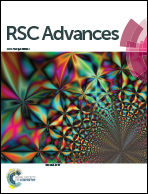Intra-arterial infusion of PEGylated upconversion nanophosphors to improve the initial uptake by tumors in vivo†
Abstract
An alternative method to the intravenous administration of upconversion nanoparticles (UCNPs) was highlighted by the use of an unconventional blood pathway, the artery. The uptake of NaYF4:Yb,Tm@SiO2 nanoparticles modified with polyethylene glycol (PEG-UCNPs) by MCF-7 tumors following intra-arterial (i.a.) injection was nearly three-fold higher than that obtained with intravenous (i.v.) injection. This result suggests a new method for administering UCNPs in vivo to achieve more efficient tumor targeting and therapy.


 Please wait while we load your content...
Please wait while we load your content...